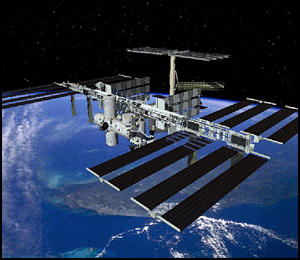International Space Station visible from Earth.

Data
Table for Viewing ISS from Ottawa
Data
Table for Viewing ISS from Renfrew County
How to Use the Tables
Note: The ISS is not always visible. Check back every
few weeks for updates.
Link
to Heavens-Above (predict location and brightness of ISS
and other satellites)
Set
your watch (precise time from the US Naval Observatory)
Iridium
Satellites (information about Iridium flares)
Even though it is a small object at a considerable distance, the ISS
sometimes becomes visible to observers on earth.
The ISS orbits the earth every 92 minutes at an average altitude of
380 km. If you know where and when to look, it is actually possible to
see this space vehicle when the sun reflects off of it against a dark sky.
The ISS looks like a bright star moving quickly, it is usually visible
for between 2 and 5 minutes. This phenomenon occurs most frequently shortly
after sunset or just before sunrise.
Until recently, predicting the position of satellites required sophisticated
knowledge of the mathematics of orbiting objects. The Internet now
makes all of this information available at a number of sites. One
of the best sites is http://www.heavens-above.com,
run by Chris Peat. This excellent site is easy to use and provides
data on hundreds of interesting space objects.
Once you have accessed heavens-above.com, navigating is relatively easy.
Start by clicking on "Select from our database" then choose Canada
from the list provided, next enter the name of your community (Ottawa)
in the search string box. When the search is completed, click on
your community (ie. Ottawa) which will take you to the main satellites
page. Selecting ISS will create a data table with all the information needed
to know where and when to look to see the International Space Station.
Note that the table uses a 24 hour clock.
The ISS always moves from West to East. If you are viewing in the morning
you may see the ISS suddenly appear high overhead, this is because it has
just moved out of the earths shadow, similarly in the evening you may witness
the ISS abruptly disappearing as it moves from bright sunlight into the
earth's shadow. At some times of the year the ISS is not visible at all.
Many other objects are listed at the heavens-above site including
other bright satellites and space debris such as rocket bodies. One
of the most interesting listings at the site is the Iridium Satellite series.
These satellites provide direct telephone links. Their antennae consist
of flat, mirror-like surfaces that reflect bright, narrow beams of sunlight.
When viewed from earth these satellites appear like a brief, brilliant
flash. The phenomenon is called an Iridium flare. Click on the Iridium
Flare table for the next available flares in your community.
More about Iridium satellites can be found at: http://www2.satellite.eu.org/sat/vsohp/iridium.html#flare
You must know the time accurately to use this information properly.
Set your watch using the precise time available at this site: http://tycho.usno.navy.mil/what.html.
Return
